
* During the Vietnam War, the US military realized the need for a specialized light aircraft to perform the "counter-insurgency (COIN)" mission, and after consideration of various offerings selected the twin-turboprop North American Rockwell "OV-10 Bronco" for the role. The Bronco proved very useful in the target spotting, light attack, and other roles in Vietnam, and continued its useful career with the US military up through the Gulf War in 1991. It was also supplied to several foreign air arms and remains in lingering use. This document provides a history and description of the OV-10.
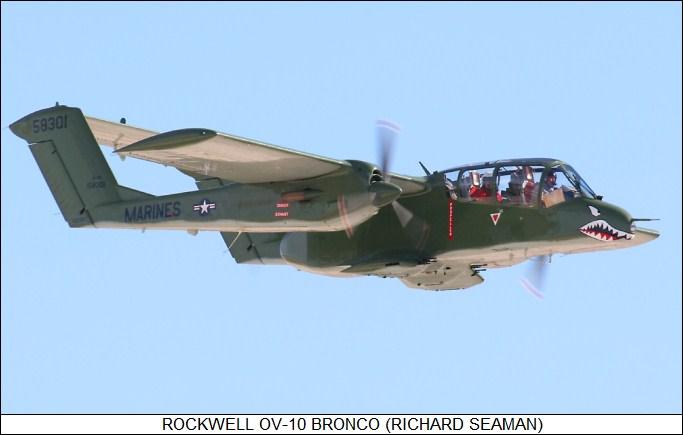
* During the World War II, the US military had made use of light civil aircraft for directing artillery and close air support, and found the scheme extremely effective. Spotter aircraft were also used in the Korean War to good effect, and in the late 1950s, the US Marine Corps began to investigate a spotter aircraft specifically designed for the task. The Marines wanted a machine that would be cheap to obtain and operate; easy to maintain and fly under rough field conditions; have improved survivability; and carry light armament, both to engage enemy forces and to fly escort for helicopter groups. The US Army was interested in a conceptually similar armed spotter aircraft.
When the Kennedy Administration took office in 1961, the concept of an armed spotter aircraft neatly fit into the new government's increased emphasis on fighting "brushfire wars", like the conflict then smoldering in South Vietnam. An armed spotter seemed like an excellent basis for a "counter-insurgency (COIN)" aircraft for jungle fighting. Such a cheap, simple aircraft could be used by US forces, and by the forces of US allies that might find a more sophisticated machine too expensive and beyond their ability to operate. Kennedy's defense secretary, Robert McNamara, was big on "defense commonality", pushing the services to acquire common equipment to lower unit costs and simplify logistics and training. Accordingly, in early 1963, McNamara set up a committee with representatives from all the combat services to develop a specification for an armed spotter / COIN aircraft.
McNamara's emphasis on defense commonality led to some major defense procurement fiascos, but it had its successes as well. The specifications the committee issued for a "Light Armed Reconnaissance Aircraft (LARA)" at the end of 1963 might have given some cause for worry, since they specified an aircraft with a high standard of operating capability and applicability to a wide range of roles. The LARA specification called for a machine with twin engines and a two-man crew. It would be able to operate off rough forward airstrips, with a loaded takeoff run of 360 meters (800 feet); have a maximum speed of 565 KPH (350 MPH); be able to loiter over a combat area for an hour at a maximum radius of 80 kilometers (50 miles); and fly safely on a single engine.
The LARA was to be armed with four 7.62-millimeter (0.30-caliber) machine guns with a total of 2,000 rounds of ammunition, and have wing hardpoints for up to 1,100 kilograms (2,400 pounds) of ordnance. Possible munitions included bombs, cluster munition dispensers, unguided rocket pods, heavy gun pods, and even Sidewinder air-to-air missiles (AAM). The LARA was also supposed to serve as a light transport, with a cargo capacity of 900 kilograms (2,000 pounds), or six paratroopers, or two stretchers with an attendant. As if that wasn't enough, it was also supposed to be able to fly off aircraft carriers, or be adapted to float operation.
Aircraft designed to such "one size fits all" specifications tend to have troubled development histories and not prove very satisfactory in operation, but in this case the specifications proved remarkably foresighted. Although the LARA that actually emerged would never serve in all the roles envisioned for it, the flexibility inherent in its specification would allow it to do some things that it was never particularly expected to do.
* US aircraft manufacturers were very interested in the LARA program, and eleven submitted proposals in response to the committee's request. Seven proposals -- from Beech, Douglas, General Dynamics, Helio, Lockheed, Martin, and North American Rockwell -- were picked for further consideration. The Rockwell design, the "NA-300", was selected in August 1964, and the company was awarded a contract for seven prototypes in October. Some of the competitors challenged the selection, but the military rejected the challenges. Convair, incidentally, went ahead and completed a prototype of their offering, the "Model 48 Charger", which had a strong similarity to the NA-300; the Charger was put through trials, but nobody wanted it.
The first NA-300, or "YOV-10A" as the military designated it, flew on 16 July 1965 from the Rockwell plant in Columbus, Ohio. Rockwell chief test pilot Ed Gillespie was at the controls, and the machine featured "tri-service" (Army / Air Force / Navy-Marines) markings. The first flight was only nine months after award of the contract. The remaining six prototypes were all delivered by 7 October 1966. After intensive evaluation that dictated a number of changes, the type was cleared for production as the "OV-10A Bronco" in early 1968, and first production machines were formally handed over to the Marines and the USAF in an official ceremony at Columbus. The Bronco was in combat by the summer of that year. The USMC eventually obtained a total of 114 OV-10As; the USAF a total of 157.
BACK_TO_TOP* The OV-10A Bronco that emerged from this development process was a neat aircraft, featuring twin turboprop engines, one in a boom on each side of the aircraft, a high-mounted wing, a high-mounted tailplane between the booms, a central fuselage with a tandem-seat cockpit under a bug-eyed canopy, and retractable tricycle landing gear.
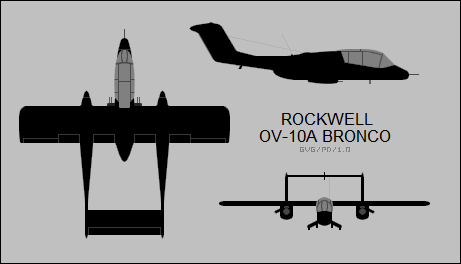
The engines were "handed", meaning they rotated in opposite directions to reduce the effects of torque. A Garrett-AirResearch T76-G-10 turboprop was mounted on the right and a T76-G-12 was mounted on the left, with both engines providing 535 kW (715 SHP) and driving three-bladed variable pitch propellers. The positioning of the engines and fuselage under the wing gave service crews access to most systems from the ground level, and also improved the view of the aircrew, an important consideration in a spotter aircraft.
The wing had a simple rectangular form, with four spoilers on top outboard of each engine. The spoilers were of unusual configuration, consisting of quarter circle sections that rotated out of the wing; they not only served as air brakes and lift dumpers, they worked in conjunction with the ailerons to improve roll control. The tailfin on each boom was swept. The high-set tailplane featured balance weights to reduce flutter.
___________________________________________________________________
ROCKWELL OV-10A BRONCO:
___________________________________________________________________
wingspan:
12.19 meters (40 feet)
wing area:
27 sq_meters (291 sq_feet)
length:
12.67 meters (41 feet 7 inches)
height:
4.62 meters (15 feet 2 inches)
empty weight:
3,127 kilograms (6,893 pounds)
loaded weight:
6,552 kilograms (14,444 pounds)
max speed at altitude:
450 KPH (280 MPH / 245 KT)
service ceiling:
7,315 meters (24,000 feet)
range:
925 kilometers (575 MI / 500 NMI)
___________________________________________________________________
The cockpit featured the pilot in front and the observer in the back. The canopy was bulged to give the aircrew a good field of view. There were upward-folding panels on each side of the canopy, with the crew using the right-side panels for normal entry and exit, while the left-side panels could be used as emergency exits. Pop-out steps were fitted on the fuselage on the right to allow the aircrew to "saddle up".
Both crewmen rode in Rockwell LW-3B "zero-zero" (zero speed / zero altitude) ejection seats, with a wedge mounted on top of each seat to punch through the top of the canopy. The observer could eject on his own, or the pilot could eject both himself and the observer. If both aircrew ejected at once, there was a slight delay between ejection of the pilot and ejection of the observer and the seats were ejected to different sides of the centerline, to prevent collisions.
The Bronco featured a cargo compartment behind the observer. The end of the fuselage hinged open to the left to allow access at a convenient low level to the ground. The cargo compartment had a volume of 3.12 cubic meters (110 cubic feet), and a total of 1,450 kilograms (3,200 pounds) of cargo could be carried. Although the Bronco would not often be used as a cargo carrier -- it seems airdrops were performed on occasion, with the tailcone removed for such sorties -- this feature would prove very useful for modifications of the machine.
Gun armament consisted of four M60C 7.62-millimeter machine guns with 500 rounds per gun, with two guns mounted in a sponson and angled down. The M60Cs were variations of the standard infantry M60 machine gun, modified for fixed aircraft mount. The guns could be easily removed from a hatch on top of each sponson. The cockpit was fitted with a simple gunsight for the pilot. There were two stores pylons under each sponson, a centerline stores pylon, and a stores pylon under each outer wing, for a total of seven pylons. The sponson-mounted pylons were low to the ground, which made loading up the machine easier. The centerline pylon was "wet", allowing it to carry an external tank. Originally, the Bronco could carry a 568-liter (150 US gallon) or 872-liter (230 US gallon) external tank, but a 1,137 liter (300 US gallon) became standard.
Some sources claim the wing pylons were "wet" as well, but this appears to have not been the case in the original production configuration. The wing pylons were wired to carry AIM-9 Sidewinder AAMs, presumably for the anti-helicopter role. It was a simple fit, since all it required were wires to control launch and link the missile's seeker to the pilot's headphones. The seeker emitted a tone that was fed to the headphones to tell the pilot when the missile was locked on target and ready to fire.
The main landing gear retracted backward into the tailbooms, while the nose gear retracted forward. The nose gear could be steered up to 55 degrees to each side. The gear was very rugged, with the main gear featuring a double-telescoping shock absorber assembly, to permit short-field, high angle-of-attack landings, and used low-pressure "fat tires" for handling on rough surfaces. Incidentally, there's no convincing evidence the Bronco was ever actually kitted up with floats, though it would certainly have been interesting to see.
The production OV-10A differed in several noticeable respects from the prototypes. The initial YOV-10A had lacked the gun sponsons, had a wingspan shorter by 1.5 meters (5 feet), and was powered by T76-G-6/8 engines, with only 492 kW (660 SHP). The later prototypes had the gun sponsons, but they were originally set level with the aircraft's line of flight, while in production aircraft they were angled slightly downward -- mostly to ensure clean separation of ordnance loads. The seventh prototype was fitted with Pratt & Whitney Canada PT6A turboprops to evaluate a possible alternative powerplant. After the tenth production aircraft was rolled out, OV-10As were built with a small "fillet" at the base of each tailfin to improve yaw stability. The fillets were retrofitted to the earlier machines.
BACK_TO_TOP* The Marines performed the first combat sortie of the Bronco on 6 July 1968. The USMC learned to like the OV-10A very much. While they used it heavily as a spotter, they also flew it in the light attack role, and for helicopter escort.
The Air Force had a small group of Broncos in operation by August 1968 for combat evaluation to pave the way for large-scale deployment. The Air Force was reluctant to use the Bronco in anything but the spotter role -- carrying external ordnance no more lethal than 7-round 70-millimeter (2.75-inch) rocket pods, for marking targets with smoke rounds -- and in fact, after a Bronco was lost in combat, the order would generally come down from the brass to have the M60C machine guns removed, so that pilots wouldn't be tempted to perform "unnecessary heroics". Sooner or later, the guns would be reinstalled, then somebody would get cocky, get shot down, and the whole cycle would start all over again. Late in the war, however, it does appear that the Air Force did task the Bronco with light attack responsibilities.
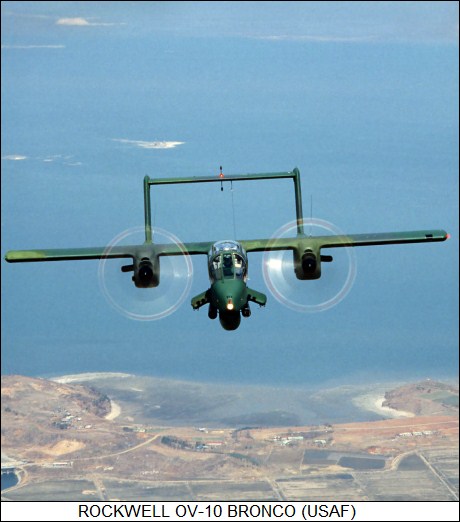
Since every Marine felt that shooting back was his given right, nobody ever thought of ordering the removal of the guns from Marine Broncos. In fact, the Marines fitted their OV-10As with a wide variety of weapons, including 70-millimeter rocket pods, carrying rockets with both smoke and more lethal warheads for attack sorties; 4-round pods for the big 12.7-centimeter (5-inch) Zuni rocket, for the attack role; and the 7.62 millimeter Gatling "Minigun" pod. Late in the war, the Marines liked to fit Broncos with a Minigun pod on each sponson and a 20-millimeter cannon pod on the centerline pylon, calling the result a "Super Gun Bird". Broncos could be used in night combat, with one or two sponson pylon attachments fitted up with a parachute flare rack, each rack carrying six flares.
One interesting application of the Bronco was its use in dropping seismic sensors along the Ho Chi Minh trail under the IGLOO WHITE program. The sensors were supposed to pick up the movements of trucks, and radio data back to a central command center. The command center would assimilate all the sensor inputs and direct air strikes as necessary. IGLOO WHITE was a failure -- but it was an interesting idea for a future time when better technologies were available.
* The US Navy got interested in the Bronco late in 1968, and in 1969 borrowed OV-10As from the Marines to form up squadron VA(L)-4, known as the "Black Ponies". This was almost strictly an attack unit, tasked with supporting US Navy river patrols and SEAL commando operations on the Mekong. The Black Ponies would fly in two-ship groups, with one machine carrying a 20-millimeter gun pod, the other carrying a Minigun pod, and both carrying rockets.
Aircrews found the Bronco maneuverable, with the spoilers providing an excellent rate of roll, but it was underpowered; if one of the engines was lost at airspeeds below 220 KPH (120 knots), standard procedure was to punch out immediately. As the Bronco almost always operated at low altitude, going into a dive to build up speed was not usually an option. Since the OV-10A also lacked cockpit air conditioning, the crew could get uncomfortably hot in the greenhouse canopy.
BACK_TO_TOP* Although the Air Force had mixed feelings about the Bronco, the service was interested enough in the type to decide to enhance the machine for improved targeting and night / all-weather operation. In 1970, LTV Aerosystems modified 14 Broncos to the "OV-10A PAVE NAIL" configuration, which featured a laser rangefinder and target designator, a stabilized night sight, and LORAN radio navigation system gear. The laser target designator allowed the OV-10A PAVE NAIL machines to guide the new laser-guided bombs (LGBs). The Air Force did not follow up this program, with the aircraft reverting back to standard OV-10A configuration after the war.
The Marines were much more enthusiastic about making greater use of the Bronco. They wanted to improve it with new sensors and heavier armament to hit the enemy at night, and issued a request to industry for such a conversion. Rockwell won the contract and modified two OV-10As to the "YOV-10D Night Observation Gunship (NOGS)" configuration, handing them over to the Marines for evaluation in 1970. The YOV-10D lacked the gun sponsons, with armament consisting instead of a three-barrel General Electric M197 20-millimeter Gatling cannon in a turret under the rear fuselage. The Bronco's cargo space came in handy for accommodating the turret systems and cannon ammunition. The nose was extended 76 centimeters (30 inches) to accommodate a turret-mounted "forward looking infrared (FLIR)" video imager. The wing pylons were replaced with new "wet" pylons that could be used to carry 379-liter (100 US gallon) external tanks. Sidewinder capability was lost.
After stateside tests, the two YOV-10Ds were sent to Vietnam for combat evaluation with the Navy Black Pony squadron. The YOV-10Ds flew over 200 sorties and proved murderously effective, in two cases crushing enemy night attacks on isolated outposts. The Marines decided to put the gunship into production, but made some changes to the configuration:
Only 18 USMC OV-10As were upgraded to the production "OV-10A Night Observation System (NOS)" configuration -- the name was changed from NOGS, since without the cannon it wasn't a gunship any more. The conversions began in 1978, with deliveries of the upgraded aircraft beginning in late 1979.
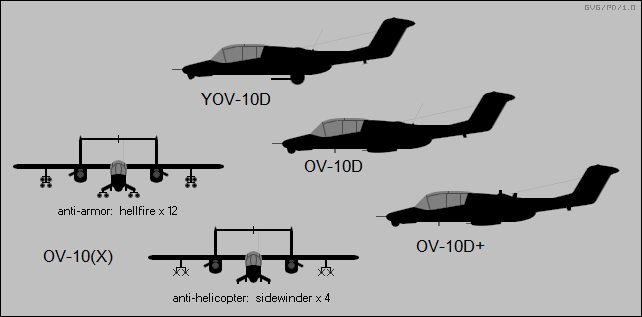
* The Marines continued to make good use of their Broncos in the 1980s, fitting both OV-10As and OV-10Ds with improved countermeasures systems. The first item was fit of two AN/ALE-39 chaff-flare dispensers, with a dispenser fitted into the middle of each outer side of each engine boom. Each dispenser could carry 30 flares or chaff cartridges. The Broncos were later fitted with an AN/APR-39 radar warning receiver, and then an AN/ALQ-144 infrared countermeasures (IRCM) system. The AN/ALQ-144 was known as a "hot brick" jammer, which radiated a thermal signal that was switched on and off by a rotating shutter to confuse heatseeking missiles. It was called a "disco light" and was mounted on top of the rear fuselage of the Bronco.
In 1985, the Marines decided to implement a more comprehensive upgrade program to bring 23 OV-10As and 14 OV-10Ds to the "OV-10D+" standard. The "D Plus" featured a service life extension for the airframe, updated engines and FLIR, and a major avionics update with a partial "glass cockpit" scheme. The avionics update gave the D Plus an outstanding tactical communications capability. Wiring for Sidewinders was also restored to the wing pylons.
Deliveries of the upgraded aircraft began in 1990, with the machines coming into service just in time to go into combat in Operation DESERT STORM, the campaign to evict the Iraqis from Kuwait. Broncos reached the theater by a number of means, including flights from the US by stages and delivery by aircraft carrier. The Broncos took off from the carriers, which they could do easily given their short-field capabilities, to reach their final land bases; they could not land on a carrier, since they lacked an arresting hook. The Marines had flown off carriers in several exercises well before the Gulf War. The Marine Broncos once again provided outstanding service during this campaign, though two were lost to Iraqi heat-seeking missiles. The Air Force did not commit their Broncos to the war, since they were regarded as too vulnerable.
Although the Marines continued to upgrade their D-Plus aircraft after the war, adding an AN/AAR-47 missile warning system, and the service life extension had been supposed to keep the Broncos flying into the 21st century, funding limitations forced the USMC to reluctantly phase out the OV-10. The last were out of service by the spring of 1994. The Air Force had already phased out their OV-10As a year earlier.
* At one time, it seemed possible that the Bronco could make a comeback. In 2009, the Air Force, confronted with a series of brushfire wars, began to express interest in turboprop COIN aircraft. Manufacturers responded to the interest with a series of proposals for turboprop light attack aircraft, most prominently modifications of the Super Tucano and Raytheon T-9 trainers. Boeing, however, proposed a new-build variant of the Bronco, the "OV-10(X) Super Bronco", with an external configuration much like that of the OV-10D -- but with uprated engines, a full glass cockpit, new avionics including a modern imaging / target designator turret, 12.7-millimeter machine guns in the sponsons, and compatibility with modern munitions, such as 30-millimeter cannon in a centerline turret, or 12 Hellfire anti-armor missiles.
Nothing happened. By that time, the light attack role had been largely taken over by drones, with piloted light attack aircraft seen as suicidal in operations against adversaries with modern air defenses. This was heavily underlined in the Russian invasion of Ukraine in 2022, in which both sides found out the hard way that flying aircraft over a battlefield meant they were usually shot down.
BACK_TO_TOP* The West Germans obtained a number of Broncos for the target tug role, replacing British Hawker Sea Furies. The Bronco target tugs lacked the weapons sponsons and carried a target tow pod on the centerline stores pylon. The target operator sat in the back of the machine, which was fitted with a glassed-in rear dome to permit observation of the target. This variant was designated the "OV-10B", and six were purchased, the first flying in April 1970.
The West Germans also obtained twelve "OV-10B(Z)" machines, which were identical to the OV-10B but had a General Electric J85-GE-4 turbojet, with 13.1 kN (1,335 kgp / 2,950 lbf) thrust mounted on the back of the aircraft on stubs mounted on the wingroots. The turbojet improved the Bronco's speed by 160 KPH (100 MPH), tripled the climb rate, and halved the takeoff run. The first OV-10B(Z) flew in September 1970. It appears that only one was supplied to the West Germans in this configuration, with the other 11 supplied as OV-10Bs and upgraded in Germany. It also appears that the jet pod proved unreliable in service, and was generally removed.
All the target tugs were operated by a civilian contractor company up to the early 1990s, when they were retired due to difficulty in obtaining spares. They were replaced by Pilatus PC-9s. Three of the German machines eventually made their way to the "Bronco Demo Team" based in the UK, which performs on the European airshow circuit.
* Thailand ordered a batch of 16 Broncos in 1969, with the first "OV-10C" was delivered in 1971. The OV-10C was basically an OV-10A without the wing stores pylons and few minor changes in kit. The Thais ordered 16 more in 1972, with deliveries beginning in 1973. Six additional machines were obtained in 1977 as attrition replacements, bringing the total to 38. The Thai Bronco fleet was phased out in 2003, with some machines passed on to the Philippines.
Venezuela ordered the Bronco in the early 1970s to replace antiquated North American B-25 Mitchells. The Venezuelan Broncos were designated "OV-10E", though they were almost stock OV-10As. The first of 16 aircraft arrived in 1973, and the aircraft were used in brush fighting, as well as during a 1992 coup, with a number of Broncos lost in the fighting. At last notice, the Venezuelan OV-10s were to be replaced by Russian Mil Mi-35 helicopter gunships.
The Philippines obtained a number of refurbished OV-10As in the late 1980s, and as noted above obtained some hand-me-downs from Thailand. They were refurbished, with the airframes "zero-lifed" and the old props replaced with new Hartzell props. They were also fitted with Global Positioning System (GPS) navigation satellite system receivers. Four more were provided in 2019. At last notice, the Filipino Broncos were still in service.
Other foreign users of the Bronco included:
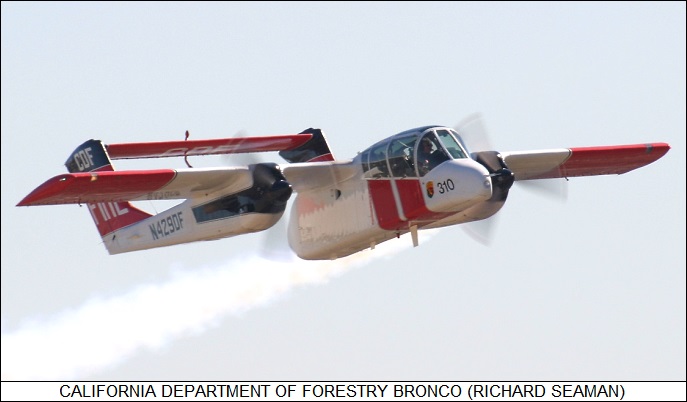
* There are a number of US civilian users of Broncos:
The remaining Broncos were given to museums, or went to the "boneyard" at Davis-Monthan Air Force Base in Arizona. The Broncos residing in the boneyard have not been scrapped at last notice, being left available for spares cannibalization or utilization by other government organizations.
The Bronco did get a curtain call to US military service in 2011, when the Special Operations Command (SOCOM) obtained two on loan from NASA for a COIN study codenamed COMBAT DRAGON II. They were brought up to "OV-10G+" configuration, with new props and new avionics, including defensive countermeasures, and evaluation of modern munitions. The program was obscure and lapsed in 2014 -- but the same machines were observed flying out of Spain in 2015, with rumors that they were being operated by the US Africa Command. It also appears that a few of these Broncos saw combat in Iraq in 2016, performing strikes with the Advanced Precision Kill Weapons System (APKWS) -- a 70-millimeter rocket with a laser-seeking head.
* During the Vietnam War, the Air Force talked with Rockwell about building a light transport based on the OV-10A, and the company came back with a concept for an "OV-10T", which was basically a Bronco with an extended wingspan and a boxy cargolifter fuselage. The new fuselage provided side-by-side seating for the aircrew, and could carry eight passengers; twelve paratroops; six stretchers with two attendants; or 2,040 kilograms (4,500 pounds) of cargo. It could also be fitted up as a gunship, or used for special missions.
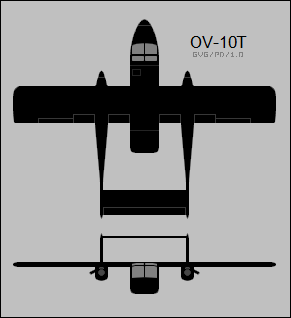
However, the Air Force lost interest, and the OV-10T never went beyond the concept stage. Rockwell came up with a few other proposals for Bronco derivatives, including one with four engines, but they never went as far as the OV-10T concept.
BACK_TO_TOP* I chose to simplify the name of "North American Rockwell" to "Rockwell" in this document. At the time of the introduction of the Bronco, I suspect that the company was still generally called "North American", but the reader should be able to make the distinction.
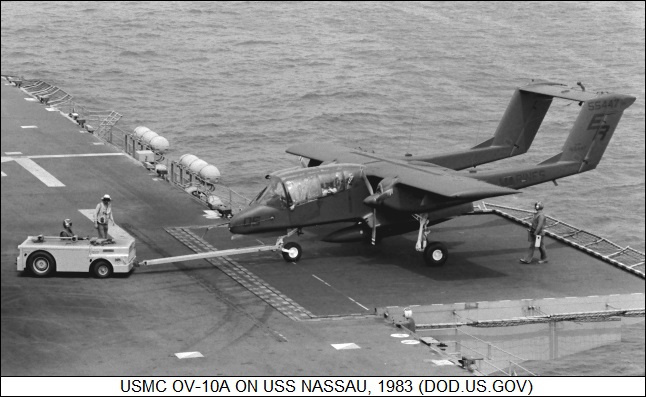
* Sources include:
Some comments were also obtained from the online Wikipedia.
* Revision history:
v1.0.0 / 01 nov 11 v1.0.1 / 01 oct 13 / Review & polish. v1.0.2 / 01 sep 15 / Review & polish. v1.0.3 / 01 aug 17 / Review & polish. v1.0.4 / 01 jul 19 / Review, update, & polish. v1.0.5 / 01 may 21 / Review & polish. v1.0.6 / 01 apr 23 / Review & polish. v1.0.7 / 01 mar 25 / Review & polish.BACK_TO_TOP
